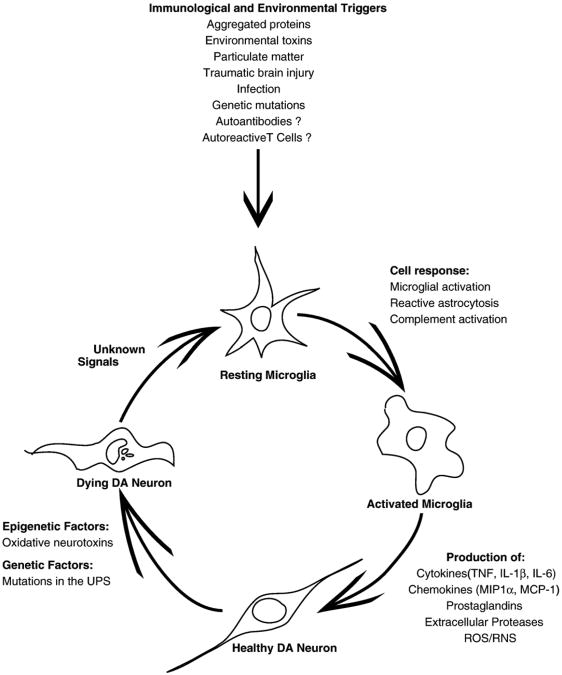Fig. 1.
Mechanisms and triggers that initiate and sustain microglia activation and contribute to dopaminergic neuron degeneration. Divergent disease initiation steps including neurotoxin exposure, traumatic brain injury, infection, and genetic mutations may converge to activate various cell types resulting in microgliosis, reactive astrocytosis, complement activation and production of autotoxic substances. This neuroinflammatory response may also include the involvement of components of the acquired immune response with the recruitment of autoreactive T cells and the production of auto-antibodies. As a result of immune system involvement, through both glial proliferation and complement activation, there is increased production of cytokines (in particular TNF, IL-1β, and IL-6), chemokines, proteases, ROS, and RNS to create an environment of increased inflammatory and oxidative stress in the SNpc that becomes self-sustaining. Alternatively, a healthy neuron may become dysfunctional as a result of genetic mutations that affect the ubiquitin proteasome system (UPS) or mitochondrial function which may sensitize DA neurons to epigenetic factors (i.e., oxidative neurotoxins, neuroinflammation). Subsequent exposures to neurotoxic agents and inflammatory insults can also act to hasten the degeneration and death of DA neurons. Regardless of the factor that causes the initial cell death, the resulting immune response contributes to an auto-amplifying cycle of microglial activation sustained by microglial-derived autocrine factors. Lastly, the presence of dying or dead DA neurons may be accompanied by the generation of unknown signals which target a neuron for phagocytosis by activated microglia. Self-perpetuating cycles of neuroinflammation and neurotoxicity in the nigra would ensure the progressive destruction of DA neurons as an individual ages.

